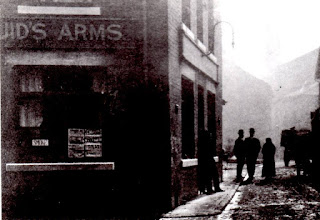 |
| The former Pilkington Arms pictured in August 2015 (Google Streetview) |
There
is a common misconception that the Pilkington Arms was named after the family
whose crest still appears on the Man and Scythe, Churchgate. While it was named
after a member of the Pilkington family it was perhaps a different branch. John
Pilkington built the pub in 1803 on Derby Street on the corner of what later became
Noble Street and he simply named it after himself.
By 1820 John Pilkington had gone. A Mr Hiles is named as the landlord on the
1818 Bolton Directory and he was subsequently replaced by Richard Ryley. By the
mid-1830s, Edward Smith was the proprietor. Pubs were often the centre of
communities and were used for formal administrative proceedings. In 1841, the
Pilkington was used by the local coroner for the inquest into the death of
Edmund Fairclough, aged four, who died in a fire at the family home on nearby
Houghton Street. Edmund’s mother went out to a bakehouse and locked Edmund and
two other children in the house. When she returned Edmund was on the bed his
clothes having caught fire. A verdict of accidental death was returned.
Edward
Smith left the Pilkington around 1850. By 1851 he was a coal and house agent
living on Blackburn Street, the name for what we now know as the bottom end of
Deane Road. By the time he died in 1873 he was living alone in a boarding house
on that same street.
Edward
Smith was succeeded by William Seddon and his wife Ellen. William was the son
of a farmer from Morris Green and the couple were running a beerhouse at
Daubhill in 1851. By 1854 they were at the Pilkington Arms and they were to
remain there for the rest of their lives. William died in 1870 and Ellen took
over the running of the until her death in 1873. She was also described as the
pub’s brewer according to the Bolton Directory of 1871. William Beckwith
succeeded the Seddons and he ran the pub until his death in 1881 at the age of
39.
The
Pilkington subsequently fell into the hands of Walkers Brewery on Spa Road. No
relation to Walker Cain of Warrington, Walkers of Bolton was situated opposite
Queens Park. Magnet stands on the site of the brewery which was owned by a
number of companies during its 80 years of operation, latterly Howcroft’s which
closed in 1969. Walker Street, off Spa Road owes its name to the brewery’s
founders.
In
1899 the Walkers operation was being wound up and the Pilkington was one of a
number of properties in Bolton and Preston being sold. [1] The job lot became
part of the newly-formed Spa Wells Brewery Company in 1900.
Spa
Wells lasted four years. It became J Jackson and Sons in 1904. Jackson’s sold
out to Shaw’s of Leigh in 1927. Shaw’s were taken over by Walker Cain Ltd in
1931 and Walker’s merged with Tetley of Leeds in 1960 to form Tetley Walker.
The
Pilkington was in the Good Beer Guide from 1994 to 1996. At the time it had
been in the hands of the Richardson family for some 20 years. It closed down in
2007 and can be seen here in January of that year.
 |
| The Pilkington in 2007 (image Johnmightycat on Flickr) |
The
Pilkington was converted into a takeaway. It was Bar B Q Base in 2008, Tariq’s
in 2011 and, more recently, it became the Xquisite shisha, mocktail bar and
grill in 2015.
[1]
The other Bolton pubs were: the Milestone on Deane Road; the Queens Arms,
Bridge Street; Uncle Tom’s Cabin, Egyptian Street; the Waterloo Tavern on Folds
Road; the Sir Colin Campbell Road on Folds Road; the Mere Hall Inn on Vernon
Street/Lyon Street; the Union Arms on Deane Road; the Red Lion at Four Lane
Ends and the Church Hotel in Kearsley.













